Before I blog about the second day’s sessions, which were great, I thought I’d upload and link to my Flickr set for Defrag. We’re in the last session right now, about information overload, and here I am multi-tasking and overloading myself…. 🙂 But it just comes naturally to us information freaks, I guess! Pretty much everyone else here is doing the same: checking email, reading stuff on their laptops, blogging, writing business plans, who knows! This has been a fun event. More soon….
Tag: enterprise 2.0 (Page 2 of 3)
The afternoon session on Monday focused on several interrelated topics, starting with a talk by Alex Iskold on "Structured Attention." I caught the beginning part of this one, then had to jump over to a concurrent session. Alex said there are three types of recommendation engines: personal, social (collaborative filtering), and genetic (like Pandora). 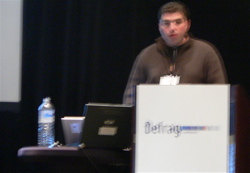 "But the problem is they’re silos," said Alex, "and we don’t own them." Thus, the gist of Alex’s treatise it that we need "Web Wide Attention." The way it stands now, "No single site knows all about me." He said that has to change.
"But the problem is they’re silos," said Alex, "and we don’t own them." Thus, the gist of Alex’s treatise it that we need "Web Wide Attention." The way it stands now, "No single site knows all about me." He said that has to change.
The other breakout session I then joined was one by Peter Semmelhack, founder of Bug Labs. This was a session billed as "Defragging Gadgets: Community-Driven Electronics." But Peter titled his talk "Hardware Innovation 2.0" — positing "what if we made all technologies available in Lego-like fashion?" 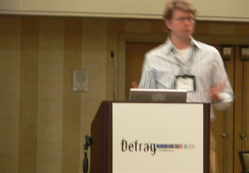
His startup company is developing an open platform for physical devices, and 81 snap-together modules, along with web-services based interfaces, resulting in three million combinations. Peter spoke of The Long Tail of Gadgets, which he described as "millions of devices for the few instead of a few devices for the millions."
Thus, his company is talking about niche, customized devices, to meet the application needs of narrow markets (even individuals). He even went to far as to suggest that this concept will disrupt the consumer electronics business, calling it "the age of personal electronics." 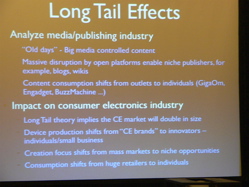 He said later, however, that Bugs Labs’ target audience is only early adopters (and, I would say, only the geeky ones), "by no means mass consumer." Thus, I fail to see how it would really disrupt an entire industry. And no one asked about where product design fits into the equation, once he showed us how the modules snap together, appearing rather kludgey. (He showed CPU, digital camera, LCD, and GPS modules, for example.) It is nonetheless an interesting concept, and Peter did say his firm is seeing a niche market for firms that are now locked into proprietary platforms and have a need to quickly and easily convert to an open platform. He also said they’re seeing interest in the area of home automation.
He said later, however, that Bugs Labs’ target audience is only early adopters (and, I would say, only the geeky ones), "by no means mass consumer." Thus, I fail to see how it would really disrupt an entire industry. And no one asked about where product design fits into the equation, once he showed us how the modules snap together, appearing rather kludgey. (He showed CPU, digital camera, LCD, and GPS modules, for example.) It is nonetheless an interesting concept, and Peter did say his firm is seeing a niche market for firms that are now locked into proprietary platforms and have a need to quickly and easily convert to an open platform. He also said they’re seeing interest in the area of home automation.
Esther Dyson took the stage next for a brief discussion on Attention. The problem of data privacy is a huge one, she said. There’s data being misused for criminal reasons, but also many other semi-legitimate uses, which may not be criminal, but are still very bothersome. "Consumers really have no idea what’s going on," Esther said. "No one reads disclosure statements." 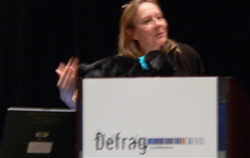
She also commented on the strange dichotomy that advertisers can deliver such personalized messages to you, but "why can’t they deliver your personalized data to you, as consumers?" She also commented on how consumers have changed: "Facebook and other scoial networks have changed the ambient notion of what a ‘profile’ is. We’re beginning to understand ‘selective disclosure’ — and even moreso if you’re younger." Esther also put forth the intersting notion that Facebook is "advancing narcissism — which isn’t really making advertising any better — people will enhance their profiles to get better treatment from advertisers." She closed by saying that "Consumers want to be able to be selective with letting out their data, but they don’t know how." But, as consumers, she said "You can demand things. You have the power to demand metadata that is meaningful."
Another great talk at the end of the afternoon was by Doc Searls, on the subject of "Vendor Relationship Management." This is all about "customer reach" rather than "vendor grasp," he said. "Why can’t you create your own profile data just once?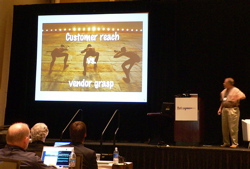 Why is the free market still ‘your choice of silo’?" Doc’s assessment is that the Industrial Age hasn’t ended yet. "And things won’t change till companies stop wanting dependent customers instead of independent ones." He pointed how ridiculous, for example, the customer agreement of Verizon is, which is some 10,000 words. "All this to basically say you have approximately no rights at all." [Love the way with words Doc has.] "In real markets," Doc said,"customers do more than just consume. What if we could help vendors instead of just carp about them? We need to manage our preferences across whole markets." He then went on to describe his Project VRM (for vendor relationship management), which he launched in his current role as a Fellow at Harvard’s Berkman Center for the Internet and Society.
Why is the free market still ‘your choice of silo’?" Doc’s assessment is that the Industrial Age hasn’t ended yet. "And things won’t change till companies stop wanting dependent customers instead of independent ones." He pointed how ridiculous, for example, the customer agreement of Verizon is, which is some 10,000 words. "All this to basically say you have approximately no rights at all." [Love the way with words Doc has.] "In real markets," Doc said,"customers do more than just consume. What if we could help vendors instead of just carp about them? We need to manage our preferences across whole markets." He then went on to describe his Project VRM (for vendor relationship management), which he launched in his current role as a Fellow at Harvard’s Berkman Center for the Internet and Society.
A week after all the buzz about Open Social, this next session was bound to be a popular one. Then again, all that hype was getting way out of control, too, which prompted conference producer Eric Norlin to put forth what he thought was more significant news last week. Nonetheless, social networking is a part of our lives now, and this highly literate audience of tech and online community types was naturally all over this discussion of where social technology is headed. This panel would address some of the ways it’s playing out now inside the enterprise. [Excuse the crummy photo — I must have been shaking in anticipation.] 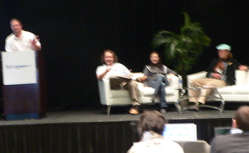
Aaron Fulkerson of Mindtouch talked about his firm’s open source wiki and
application platform for communities and enterprises, which is seeing rapid adoption. (I blogged about this previously here.) He said wikis are easy-to-use tools for creating
web-based communities, improving employee
communication and collaboration. Tens of
thousands of organizations use MindTouch, Fulkerson said,including Microsoft, Fujitsu,
British Petroleum, and Stanford University. The company’s online community of users is at OpenGarden.org.
Dawn Foster, Director of Developer Relations for Jive Software, spoke about her company’s Clearspace social community software. She said her firm now uses it for their entire intranet, and that it’s all about "open collaboration." She said she gets virtually no email internally anymore — "it’s all collaborative IM."
The guy who stole the show, though [what is it with those British accents? …and weird hats], was Charles Armstrong, CEO of Trampoline Systems, all the way from the UK. He said his background is in anthropology, which led him to focus in "social computing." He’s studied how information gets distributed in small communities, and he said "we’ve been phenomenally successful in doing that." Trampoline builds analytic systems that mimic that activity. He described his system as kind of an "upside down social networking system." He said it integrates email, document management, and other information sources, to create "employee-facing tools to find expertise." Trampoline’s customers, he said, include a UK government agency, Raytheon, a TV network, and a global management consulting firm soon to be announced.
"Do we really need social networking in the enterprise?" asked moderator Eric Norlin. "Yes, because there are lots of data silos that are completely disconnected," said Mindtouch’s Fulkerson. Trampoline’s Armstrong said, "Studies show that work gets done in enterprises in informal networks, and social networking recognizes that and puts it to use." He noted we’re just at the beginning of all this, but that "brave companies are diving in." One relatively conservative customer company of his firm, he said, has had his system running for only three months, but already has 20,000 people using it.
"What about the younger demographic in all this — what affect does that have on the enterprise?" asked Norlin. Armstrong strongly feels that, to attract and retain younger workers, social networking technology is mandatory. Fulkerson added that, "What starts in IT in the way of wiki adoption is now rapidly spreading throughout the organization."
Another question: "How do you deal with the information overload problem?" Trampoline’s Armstrong: "We help you defend yourself against it." Mindtouch’s Fulkerson: "There’s no such thing as too much information, just not enough tools to filter it."
And a final sobering question: "Is there a possibility for individual employees to remove their info from a corporate social networking system?" Not under current law, said Armstrong. "We do have ways to split your corporate and personal data, however." Fulkerson said his firm also has such tools. "But what if I have an idea over lunch?" yelled Chris Locke from the audience. Armstrong: "If it’s put up on the wiki or email or social networking system at work, it’s company property."
UPDATE (11/6): For some great insight into social networking in the enterprise, see my colleague Alex Iskold’s post today on Read/Write Web, resulting from a conference last week back East. (Alex is also here at Defrag.)
Before lunch on Monday, Jerry Michalski kicked off a session based on the "unconference" model, dividing the audience up into discussion groups. He also said it was similar to the BarCamp conference concept. Anyone could come up to the whiteboards and define a discussion topic. Once all slots were taken, audience members were invited to choose the topic in which they were interested, and move to the area where that group was assigned. Here are a photos of two of the sessions, along with the two whiteboards listing the topics. They ranged from "Vendor Relationship Management" to "Corporate Expert Knowledge Management" to "Closed Private" (the opposite of Open Social!) to "Who Owns Implicit Data"…and more. 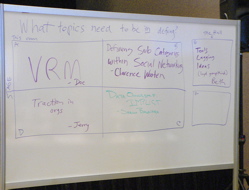

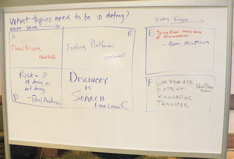
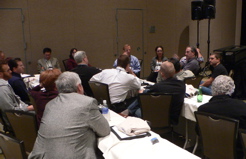
Jerry Michalski moderated a panel that was organized at the last minute when Clay Shirky couldn’t make it. He did an excellent job, as did the panelists. They were J.P. Rangaswami, CIO of BT Global Services; Joshua Schachter, founder of Del.icio.us (now Yahoo); and J.B. Holston, CEO of Newsgator. J.B. said an ‘aha’ moment for him was discovering that people interact with automated systems in much the same manner they interact with people, and the rules he found were much the same as editors use to figure out how to interact with their audience. He said a challenge for social apps in the enterprise is how to get people to open up. "How do we cache information from retiring employees, people who didn’t talk much?" The data in their online profiles is hardly enough.
J.P. said he’s learning a lot about online communities at BT. One thing is that people "will often gang up on those trying to game the system." But, he said, "you don’t want to try to stop the kind of collaboration that takes place in the real world" — whatever that may be — the implication being that there are no rules there.
Michalski chimed in that social networks are "really a different way of being in the world," and "what’s doing in the world of the enterprise?" J.P. says he wants his people to focus on the customer benefit, and be candid — "Make a video of what you’re doing and share it," noting that kids today are more comfortable with doing this, being candid and instantaneous. Michalski suggested that the value now is exposing the assets. Joshua Schachter said, yes, "Putting things out there is more valuable than the information itself. People are realizing that." Still, said J.P., there are too many silos. There’s a great deal of social knowledge in corporations, studies show, said Schachter, "but it’s not in computers." The challenge, said Newsgator’s Holston, is to "make it easy, like poking someone in Facebook, or people won’t do it."
Schachter said social apps all have two things in common: individual utility and network utility. "The notion of forwarding," he said, "is very powerful from a social standpoint." He said he gets most of his news from his team’s Del.icio.us tags. It’s not just news stories that he’s interested in. Yes, said Michalski, there’s been so much emphasis on the flow of normal media — "but it’s different now." How do we access the blogs that are most relevant?" asked Holston, rhetorically. He also suggested that we look to the real world for how virality works.
Michalski said he’s now teaching corporations how to help employees let go, be more open. An audience questioner said geeks seem to be more open and comfortable sharing, but how do we get the rest of the organization to do that? Schachter said social activity "is keyed off tribal behavior." He also said we need to build smaller, more effective organizations. J.P. said the covenant between employers and employees has changed. "The social relationship has a lot more power than information." Holston said that corporations get that command-and-control is gone — that doesn’t slow down adoption. He said ROI is needed — "It’s hard to get adoption till you do that."
As the audience questions continued, Schachter made the point that intelligence isn’t just about knowledge. "It’s also about decision making." He also said Wikipedia is good, but he questions how scalable it is. "Knowledge forces a redistribution of power, which is not necessarily bad." J.P. made some closing points: "Social intelligence is not group think. What brings people together is common interest. Things come out of the network that aren’t associated with any one individual." Moderator Michalski got the last word, saying that he thinks "group think is entirely possible with the new tools."

Recent Comments